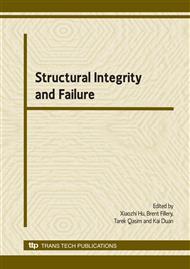p.83
p.91
p.99
p.105
p.113
p.125
p.135
p.141
p.147
On the Use of Mechanical Weight Functions for Practical Evaluation of Thermal Shock SIF's in Flexibly Restrained Edge-Cracked Plates
Abstract:
Two practical methods have been used to estimate thermal shock stress intensity factors (TS-SIF`s) associated with a flexibly restrained cracked plate. The first method used a traditional mechanical weight function (MWF) methodology in conjunction with the MWF derived for an equivalent freely restrained cracked component. The second method used a traditional MWF methodology in conjunction with the MWF derived for an equivalent rigidly restrained cracked component. Fracture mechanic finite element analyses were also undertaken to construct a comparative benchmark for the TS-SIF`s associated with a flexibly restrained cracked plate. The results of this comparison demonstrate the errors associated with these MWF methods to be acceptable, if and only if, the crack size is small, the crack component aspect ratio is large or the flexible boundary restraint stiffness are deemed negligible or near rigid. In addition, the curves derived with these MWF methods do not intersect and there is no obvious transition to distinguish which MWF method would be more appropriate for a given a particular flexible boundary restraint configuration. In effect, this means that these MWF methods cannot be confidently used to evaluate the TS-SIF`s associated with a flexibly restrained cracked component.
Info:
Periodical:
Pages:
113-123
Citation:
Online since:
April 2008
Authors:
Price:
Сopyright:
© 2008 Trans Tech Publications Ltd. All Rights Reserved
Share:
Citation:


